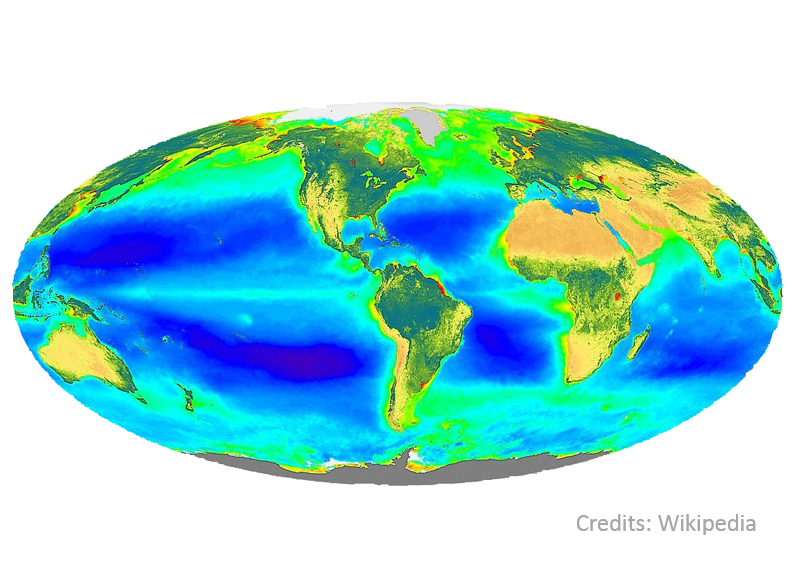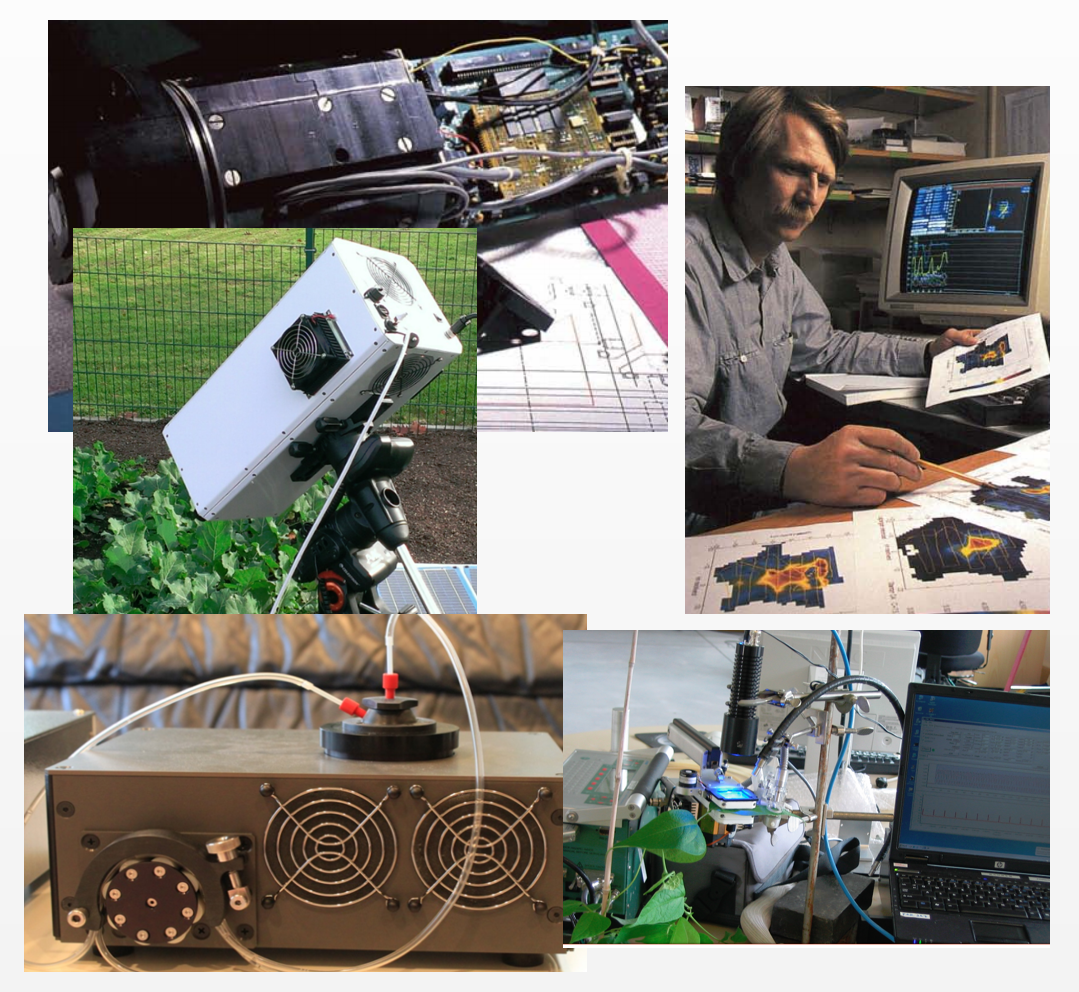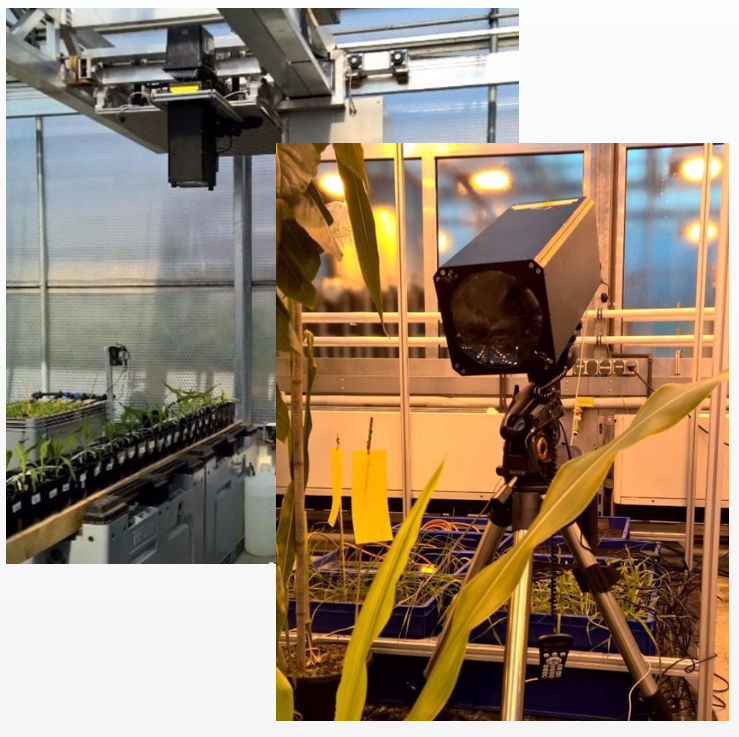Call at +1-831-334-9130, email info@soliense.com, or contact us
Fluorescence-based tools to observe and study photosynthesisSoliense Contact Form
Photosynthesis: Past, Present, and Future

Photosynthesis fuels most of the life on Earth. Using the energy of the Sun, photosynthesis initiates formation of energetically-rich chemical bonds allowing atoms and molecules to assemble into complex, self-sustaining structures of life. Photosynthesis also provides energy required for metabolic maintenance of these structures.
During the last three billion years, photosynthesis has defined patterns of life evolution on Earth. Starting as mechanism of redistributing electrons between relatively simple molecules, it has progressed toward formation of a complete photosynthetic machinery of bacterial photosynthesis about 3 billion years ago. Hampered by a shortage of available electron donors, it has advanced within the next 700 million years toward oxygenic photosynthesis, harnessing an unlimited sources of electrons from the water of the oceans.
The "waste byproduct" of photosynthesis, molecular oxygen, became the most prevalent and most potent oxidant allowing proliferation of heterotrophic forms of life. There, the photosynthetically produced biomass is efficiently burned in the oxygen-enriched furnace of respiratory processes. With robust source of energy (the Sun), and electrons (water), photosynthesis defines the present-day life on Earth. It will continue in this role in the future, reinventing itself under challenges of human-induced climate change, continuously adapting to new environmental conditions. It is unclear, however, how these adaptations will affect human race under conditions of decreasing energy, water, and food availability.
Energy, Water, and Food
Energy
The easiest problem to solve?The resources (solar power and its derivatives such as wind, waves, and hydropower) are here to stay. Human ingenuity and engineering faculties, once engaged, are likely to produce sustainable solutions to energy supply that will ameliorate the environmental crisis fostered by the current pattern of energy utilization.
Water
Will resource management do?Water will emerge as a tougher problem, requiring implementing of new land and water use policies on regional and global scales. Acceptable solution will be defined by the political and professional skills of elected officials and resource managers.
Food Supply
Still unrecognized, yet most intractable problem?
Food shortages, presently experienced by the poorest nations, are likely to become more prevalent in the future due to rapidly changing weather patterns, soil erosion, diminishing water supply, and the increasing costs of phosphate mining. Engineering and policy alone are unlikely to provide satisfactory solution. Instead, a substantial progress in the scientific inquiry of photosynthesis will be required to identify the most promising approaches toward satisfying the nutrition needs of growing human population.
"Sustainable food security and increasing availability of plant biomass for human nutrition and bioindustries is the key challenge for the coming decades. Understanding the physiological and genetic basis of plant growth and its translation to crop improvements is vital to address the future challenges. This requires concerted action to closely interact between different stakeholders to evaluate and map the demand for phenotyping, available infrastructure, to evaluate the opportunities and limitations, and to discuss strategies for the development of the plant phenotyping community" (http://www.plant-phenotyping.org/ippn-survey2016).
Less acknowledged, but equally troubling are the increasing eutrophication of the coastal oceans, progressive ocean acidification, and the anticipated decrease of nutrient fluxes to the upper oceans due to ocean stratification. Oceanic photosynthesis will respond by modifying patterns of nutrients and light utilization, altering the existing pathways of carbon cycle, and reshaping the composition of marine species. These adjustments may affect the ability of the ocean to buffer atmospheric carbon dioxide, further accelerating changes in ocean physics, chemistry, and biology. These changes may destabilize existing weather patterns, the most critical factors controlling terrestrial vegetation. And we will have absolutely no control; there is no room for "planting trees" in the ocean...
Photosynthesis is the most sensitive parameter in the equation of environmental stability. New, climate-related variables introduced by the practices of industrial age have already changed the stability criteria of this equation. Understanding how, and by how much, emerges as the most challenging problem in environmental sciences. Less glamorous, yet increasingly important question is how this equation will determine the trajectory of food production and nutrition sustainability. Highly nonlinear, with multiple levels of positive and negative feedbacks, this equation remains unsolvable under current limits of knowledge. Systematic observations of photosynthesis on the land and in the ocean, coupled with an array of well-designed experimental programs, represents the shortest path toward solving this equation.
Objectives

At SOLIENSE we concentrate on the biophysical aspects of these challenges.
We develop fluorescence-based methods and techniques for observing and characterizing terrestrial and marine photosynthesis in situ,
in real time, with high temporal resolution. Chlorophyll fluorescence is the most accessible signature of photosynthetic activity.
Interpretation of this signal allows assessing photosynthetic performance on levels of light utilization, primary photochemistry,
and the photosynthetic electron transport. We work toward making these techniques available for field measurements and for laboratory-based experimental work.
Fluorescence-based characteristics of photosynthetic activity may also serve as a robust indicator of
plants physiological performance in terms of crop yields under varying conditions of light, nutrient status, and temperature and water stress.
The complexity of fluorescence responses, overwhelming at a first due to very dynamic relationship with environmental conditions and experimental protocols,
provides extremely rich source of information about the architecture and function of photosynthetic apparatus, and the ensuing physiological traits of plants.
Efforts toward understanding and interpreting chlorophyll fluorescence have already
established a solid link between parameters such as Fv/Fm,
the photosynthetic efficiency, and plants productivity. Nonphotochemical quenching, one of the most investigated phenomenon in plant photophysiology, was recognized as a
critical factor controlling plants tolerance to excess of light. There is a strong indication that other parameters, such as functional absorption cross-section of Photosystem II,
the kinetics of electron transport from PSII to PSI, the size of the PQ pool, the dynamics and efficacy of State Transition, and the fast-acting donor and acceptor side quenching,
will provide comparably-important information about plants
photosynthetic performance and physiological conditions. A reasonable argument can be made that these characteristics, all measureable in vivo, in real-time, non-destructively,
from a distance of up to several meters, may also aid in search for sought-after traits for food production and bioengineering .
Limitations and Opportunities: Application of fluorescence-based techniques for measuring photosynthetic performance of plants and marine organisms is no longer technology-limited. Recent advances in LED-based light sources, detector technology, electronics, and signal processing allowed expanding fluorescence measurements toward detailed characterization of photosynthetic machinery, at increasing levels of spatial and temporal resolution and engineering robustness, allowing continuous field applications for long periods of time. The cost of new technology, currently relatively high due to extensive R&D effort required, will decrease as the field of plant phenomics and intensive agriculture matures. At the end, it will be our intellectual capability to use new techniques and to distill new information into knowledge that will define the utility of fluorescence-based tools in solving the problem of nutrition sustainability.
Questions:Here, at Soliense, we provide technical capabilities and scientific expertise for performing relatively wide class of fluorescence-based measurements, in the lab and in the field, remotely, and non-invasively. With these capabilities in hand, following questions that can be addressed:
- How early in the plant germination stage can the photosynthetic properties be measured with Soliense tools?
 Probably as soon as photomorphogenesis is completed and the first foliage leaves reach a size of about 10 mm2. However, a systematic experimental work will be required
to determine the emergence of fully-functional photosynthetic apparatus. LIFT measurement can be performed at 2-3 meters distance, with no mechanical manipulation, and without disturbing the plant natural environment.
Just the ability to identify the sequence of events during jump-starting of the photosynthetic engine
and to diagnose the biophysical mechanisms of their success or failure under varying condition
of light, temperature, and water stress offers an exciting field of research.
The LIFT/FRR measurements can be performed at rates of one target/second, allowing continuous observations
of photosynthetic trajectories of large number of germinating plant in real-time. The high throughput of LIFT/FRR measurements should make this research possible.
Probably as soon as photomorphogenesis is completed and the first foliage leaves reach a size of about 10 mm2. However, a systematic experimental work will be required
to determine the emergence of fully-functional photosynthetic apparatus. LIFT measurement can be performed at 2-3 meters distance, with no mechanical manipulation, and without disturbing the plant natural environment.
Just the ability to identify the sequence of events during jump-starting of the photosynthetic engine
and to diagnose the biophysical mechanisms of their success or failure under varying condition
of light, temperature, and water stress offers an exciting field of research.
The LIFT/FRR measurements can be performed at rates of one target/second, allowing continuous observations
of photosynthetic trajectories of large number of germinating plant in real-time. The high throughput of LIFT/FRR measurements should make this research possible.
- Will these characteristics, measured at the very early growth stage, be preserved as plants mature?
There are reasons to believe that some of these characteristics, such as under or over-expression of nonphotochemical quenching, architecture and configuration PSII/PSI antenna, and ability to perform state transition, all controlled by the the genetic makeup of the organism, will be preserved later in the plant growth. Other properties, such as the functional absorption cross section and the size of the PQ Pool, will be redefined by the average growth irradiance regime and by the short-term variability in light regime. - Will these measurements provide information about the sought-after traits such as water, temperature, and nutrients stress resistance?
Presently there is no hard evidence to decisively answer this question. However, the early LIFT-based screening may provide information about presence of "unusual" properties, different from the common characteristics of particular plant species. Identifying these "outliers" should accelerate the search for new traits by concentrating cultivation efforts on these outliers. Arguably, majority of them will be less competitive compared to "common" specimens. Understanding the molecular basis for the observed deficiencies while quantifying the biophysical outcome in terms of light utilization, charge separation, and electron transport will produce new knowledge about factors responsible for such loss of competence.
Small fraction of these outliers actually may display competitive traits. Their ultimate performance in terms of crop yields and resilience will need to be verified by lengthy field trials. The LIFT-based measurement should assist in early selection of specimens that enter this pipeline, thus accelerating this process. - Could this knowledge be useful in practices of intensive agriculture?
Anticipating crops performance under varying climatological conditions may assist in weather prediction-driven planting decisions. Then, the ability of early detection of nutrient or water stress may trigger decisions for fertilizer/watering application long before physiological and morphological damages to the crops take place. Finally, observing plants responses in real-time should allow to employ a rigorous cost/benefits analysis in applying these resources. The key factor will be understanding the physiological "language" of cultivated crops. LIFT-based fluorescence signatures represents one of many such languages, but with extremely rich lexicon. We know how to listen, but the semantics still needs to be learned. Once the lines of communication are established, the crops themselves will make requests, and possibly make decisions regarding the best cultivation practices. - How the LIFT-based measurements relate to the
FLEX Mission?
 The LIFT instrument is equipped with an in-line spectrometer, acquiring reflectance spectra from LIFT target. A two channel spectrometer
will be installed in the next version of the instrument to acquire reflectance spectra simultaneously with the spectra of solar irradiance. The acquisition of the reflected
spectra can be synchronized with application of the LIFT-FRR excitation signal, or with application of the LIFT DC illumination. This will facilitate extending LIFT measurements into the
following areas:
The LIFT instrument is equipped with an in-line spectrometer, acquiring reflectance spectra from LIFT target. A two channel spectrometer
will be installed in the next version of the instrument to acquire reflectance spectra simultaneously with the spectra of solar irradiance. The acquisition of the reflected
spectra can be synchronized with application of the LIFT-FRR excitation signal, or with application of the LIFT DC illumination. This will facilitate extending LIFT measurements into the
following areas:
- Provide a ground truth information for the FLEX satellite signal.
- Cross-correlate the FLEX signal with the actively-induced fluorescence and with LIFT-derived photosynthetic properties.
- Extrapolate the localized LIFT signatures over larger spatial scales using the FLEX data as a spatial carrier signal.
- Investigate and validate novel protocols for retrieval of fluorescence emission spectra based on dynamic, 1-20 seconds responses of passive signal to varying irradiance regime induced by edges of cloud coverage.
- Investigate and validate protocols for retrieval of absorption bands due to presence of optically-active pigments in the leaf tissue.
Fluorescence in Phenomics?
LIFT-based assessment of photosynthetic properties are likely to assist phenomics investigations by acquiring:
- Photosynthetic Signatures (PS)
Arrays of photosynthetic characteristics that describe properties of photosynthetic machinery in terms of light acquisition, primary photosynthesis, and photosynthetic electron transport. Using fluorescence-based techniques, photosynthetic signatures can be acquired within millisecond time scales, in vivo, non-invasively, at a distance of up to several meters. - Photosynthetic Responses (PR)
Series of Photosynthetic Signatures acquired continuously, under varying irradiance levels, with high temporal resolution. - Photosynthetic Performance Matrix (PPM)
Families of photosynthetic Responses acquired under varying conditions of growth irradiance, temperature, nutrients, and water availability.